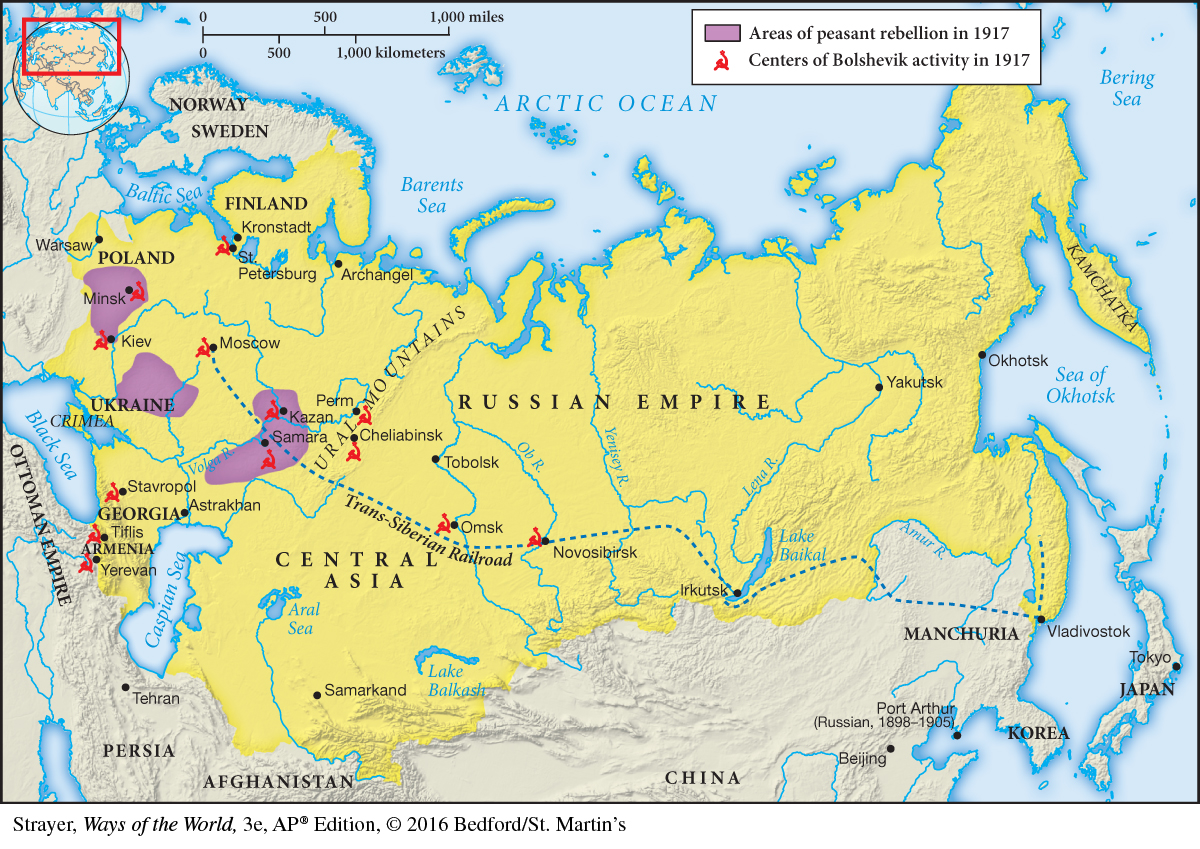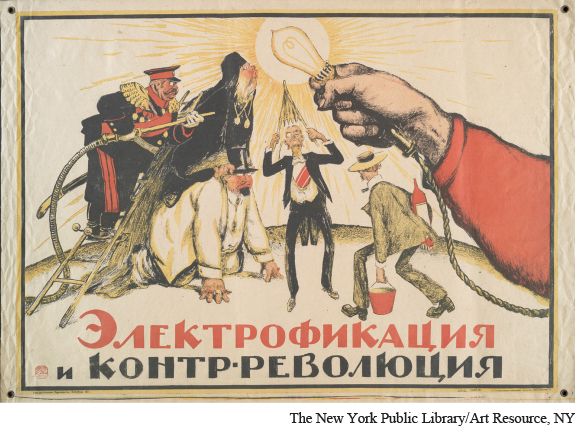Russia: Revolution in a Single Year
AP® EXAM TIP
Return to Chapter 3 and compare the causes of the fall of the Russian Empire with those of the Han and Roman empires.
In Russia, communists came to power on the back of a revolutionary upheaval that took place within a single year, 1917. The immense pressures of World War I, which was going very badly for the Russians, represented the catalyst for that revolution as the accumulated tensions of Russian society exploded. Much exploited and suffering from wartime shortages, workers — men and women alike — took to the streets to express their outrage at the incompetence and privileges of the elites. In St. Petersburg, some 100,000 wives of soldiers demonstrated for bread and peace. Activists from various parties, many of them socialist, recruited members, organized demonstrations, published newspapers, and plotted revolution. By February 1917, Tsar Nicholas II had lost almost all support and was forced to abdicate the throne, thus ending the Romanov dynasty, which had ruled Russia for more than three centuries.
That historic event opened the door for a massive social upheaval. Ordinary soldiers, seeking an end to a terrible war and despising their upper-class officers, deserted in substantial numbers. In major industrial centers such as St. Petersburg and Moscow, new trade unions arose to defend workers’ interests, and some workers seized control of their factories. Grassroots organizations of workers and soldiers, known as soviets, emerged to speak for ordinary people. Peasants, many of whom had been serfs only a generation or two earlier, seized landlords’ estates, burned their manor houses, and redistributed the land among themselves. Non-Russian nationalists in Ukraine, Poland, Muslim Central Asia, and the Baltic region demanded greater autonomy or even independence (see Map 21.1).

This was social revolution, and it quickly demonstrated the inadequacy of the Provisional Government, which had come to power after the tsar abdicated. Consisting of middle-
Guided Reading Question
▪CHANGE
Why were the Bolsheviks able to ride the Russian Revolution to power?
In the desperate circumstances of 1917, his party’s message — an end to the war, land for the peasants, workers’ control of factories, self-determination for non-Russian nationalities — resonated with an increasingly rebellious public mood, particularly in the major cities. On the basis of this program, the Bolsheviks — claiming to act on behalf of the highly popular soviets — seized power in late October during an overnight coup in the capital city of St. Petersburg.
Taking or claiming power was one thing; holding on to it was another. A three-year civil war followed in which the Bolsheviks, now officially calling their party “communist,” battled an assortment of enemies — tsarist officials, landlords, disaffected socialists, and regional nationalist forces, as well as troops from the United States, Britain, France, and Japan, all of which were eager to crush the fledgling communist regime. Remarkably, the Bolsheviks held on and by 1921 had staggered to victory over their divided and uncoordinated opponents. That remarkable victory was assisted by the Bolsheviks’ willingness to sign a separate peace treaty with Germany, thus taking Russia out of World War I in early 1918, but at a great, though temporary, loss of Russian territory.

During the civil war (1918–1921), the Bolsheviks harshly regimented the economy, seized grain from angry peasants, suppressed nationalist rebellions, and perpetrated bloody atrocities, as did their enemies as well. But they also integrated many lower-class men into the Red Army, as Bolshevik military forces were known, and into new local governments, providing them a fresh avenue of social mobility. By battling foreign troops, the Bolsheviks claimed to be defending Russia from imperialists and protecting the downtrodden masses from their exploiters. The civil war exaggerated even further the Bolsheviks’ authoritarian tendencies and their inclination to use force. Shortly after that war ended, they renamed their country the Union of Soviet Socialist Republics (USSR or Soviet Union) and set about its transformation.
For the next twenty-five years, the Soviet Union remained a communist island in a capitalist sea. The next major extension of communist control occurred in Eastern Europe in the aftermath of World War II, but it took place quite differently than in Russia. That war ended with Soviet military forces occupying much of Eastern Europe. Stalin, the USSR’s longtime leader, determined that Soviet security required “friendly” governments in the region to permanently end the threat of invasion from the West. When the Marshall Plan seemed to suggest American efforts to incorporate Eastern Europe into a Western economic network, Stalin acted to install fully communist governments, loyal to himself, in Poland, East Germany, Czechoslovakia, Hungary, Romania, and Bulgaria. Backed by the pressure and presence of the Soviet army, communism was largely imposed on Eastern Europe from outside rather than growing out of a domestic revolution, as had happened in Russia itself.
AP® EXAM TIP
Make a list of the actions Stalin took to counter Western policies in Europe after World War II.
Local communist parties, however, had some domestic support, deriving from their role in the resistance against the Nazis and their policies of land reform. In Hungary and Poland, for example, communist pressures led to the redistribution of much land to poor or landless peasants, and in free elections in Czechoslovakia in 1946 communists received 38 percent of the vote. The situation in Yugoslavia differed sharply from that of the rest of Eastern Europe. There a genuinely popular communist movement had played a leading role in the struggle against Nazi occupation and came to power on its own with little Soviet help. Its leader, Josef Broz, known as Tito, openly defied Soviet efforts to control Yugoslav communism. He proclaimed, “Our goal is that everyone should be master in his own house.”1